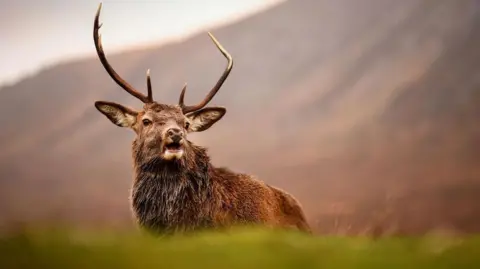Agency could intervene to cull estate's red deer
 Getty Images
Getty ImagesThe Scottish government has used a legal power for the first time to force the owners of a Highland estate to cull red deer on their land.
The compulsory deer management control scheme could see Scotland's nature agency, NatureScot, step in to reduce numbers of the animals on Loch Choire Estate in Sutherland.
There are concerns grazing by deer is damaging mossy peatland called blanket bog at four sites of special scientific interest (SSSI).
NatureScot said the action was approved by Agriculture Minister Jim Fairlie and taken after a voluntary agreement on a cull could not be reached.
The estate's Shropshire-based owners More Works Holdings have 28 days to lodge an appeal against the control scheme.
NatureScot had 160 deer culled on the estate in 2023 because it said the owners failed to manage their numbers.
The deer were processed for venison.
NatureScot said further action was needed and the estate could now be targeted with the first compulsory deer management control scheme under the Deer (Scotland) Act 1996.
The Scottish government wants the deer density on Loch Choire Estate reduced from 14 deer per square km to 7.5 within five years.
Failure to do so could see NatureScot carry out a cull and recover the costs from the estate.
The estate's owners could also be guilty of an offence under the rules of the scheme.
Robbie Kernahan, NatureScot's director of green economy, said high numbers of deer could have negative impacts on woodlands, peatlands and other habitats.
"We will always favour a voluntary and collaborative approach to deer management, working in cooperation with partners towards this shared goal," he said.
"However, we will use our intervention powers as a last resort in cases such as this, where despite significant efforts we have been unable to secure the required commitment and action through voluntary means."
NatureScot said habitats on four SSSIs on or around Loch Choire Estate were at risk.
One of the sites, Ben Kilbreck, near Altnaharra, has rocks that originated as muddy and sandy sediments in an ancient sea about one billion years ago.
Mallart SSSI is dominated by blanket bog, which provides habitat to otters and birds including golden eagles and black-throated divers.
Truderscaig is listed as a nationally important site for birds called greenshank, while Skinsdale Peatlands SSSI has extensive "carpets" of bog moss.
